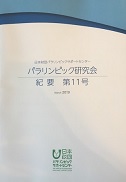With regard to the relationship between the Paralympics and awareness about people with disabilities, Watari (2007) discusses the situation at the end of the Nagano 1998 Paralympic Games. According to the study, the Tokyo 1964 Paralympic Games did lead to the development of awareness about people with disabilities, but that was what could be called “civil inattention,” a product of the festive atmosphere at the time that did not involve actually facing the realities of people with disabilities. Watari notes that the Nagano 1998 Paralympic Games led to the formation of “civil attention,” which is defined as “‘social inclusion’ and ‘understanding’ are thought to be achieved, but with a strong emphasis that it is in the context of sports, and concealing the difficult conditions faced by people with disabilities, asymmetry between the ‘disabled’ and ‘able-bodied’ categories, and physical differences.” Building on Watari’s discussion, this article aims to explore the possibility of the Tokyo 2020 Paralympic Games leading to the development of a “true interest” in disabilities and parasports.
There are three aspects to what makes parasports interesting and enjoyable: the high level of the competitions, stories of individual athletes, and unique sports techniques and strategies.
First, the level of competition in parasports has risen significantly in recent years, enabling some parasports to develop into spectator sports. However, with a few exceptions, they do not reach the exact same level as Olympic sports.
Second, is the stories of individual athletes. According to Joseph Campbell (2015), the stories of heroes share the following pattern: “Separation,” “Initiation,” and “Return.” Most of the stories of athletes and sports stars covered by newspapers and television are structured based on this pattern. We are deeply moved by stories of how athletes overcame the setbacks and sense of physical loss caused by their disabilities, as well as the process through which they developed their athletic skills and fought discrimination. Such stories may potentially lead to the dismantling of the “civil inattention” to people with disabilities and the “civil attention” to parasports, promoting understanding of the realities of people with disabilities and adaptive sports. However, since such stories stress the process of overcoming disabilities, regardless of athletes’ wishes, they also run the risk of forcing people to participate in so-called “inspiration porn.”
Third, is the sports techniques and strategies unique to parasports. Each paraathlete is in a different situation, even if they have the same disability. For this reason, no two athletes run, jump, throw, swim, or take breaths in the same way. Para-athletes identify and create techniques that suit their own situation, which is a fascinating feature unique to parasports.
I hope that there will be more extensive media coverage of the Paralympics, along with qualitative changes in news articles. Even if the Paralympics are canceled, I hope that there will be a change in the quality of the content. Media coverage is currently expanding to include class divisions and athletes’ stories, in addition to reporting results. I hope that there will also be updates on races and matches and other relevant information based on an understanding of the unique techniques and strategies developed by individual para-athletes, which would enable people to gain an understanding of parasports and learn about the “real self” of para-athletes. This may lead to the dismantling of the “civil inattention” to disabilities and “civil attention” to parasports, among other concepts that pose a hindrance to understanding, enabling people to come face to face with and understand the realities facing individual athletes, and ultimately bring about further changes in awareness about people with disabilities and parasports.
View full abstract
